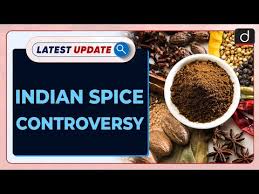FRANKLY SPICY by EFFKAY
India is in the throes of election fever, and as always, the rhetoric from our esteemed politicians is hotter than a Naga Bhoot Jolokia chili pepper. The Old Young Man and the Young Old Man and their team mates are at it, hammer and tongs The election pot is simmering, bubbling over with promises, accusations, and counteraccusations – a delightful masala mix that could put even the most daring spice blends to shame. But hold onto your taste buds, because there’s an entirely different kind of drama unfolding in the real world of commerce, and it’s got a kick of its own.
Now here’s some news that should be important to every housewife and househusband that waves a spoon in the kitchen: The Spices Board of India is currently on a crusade, wielding magnifying glasses and lab coats, as they inspect MDH and Everest processing plants.
The mission? To ensure our beloved spices meet the export standards of their destination countries. This comes on the heels of some spicy scandals abroad. On April 5, Hong Kong warned its citizens to steer clear of four products from MDH and Everest, citing the presence of pesticide, ethylene oxide (EtO). Not to be outdone, Singapore followed suit on April 18, ordering a recall of Everest’s fish curry masala, labeling it “not fit for human consumption.” Talk about a party foul!
According to the Commerce and Industry Ministry, the Maximum Residue Levels (MRL) for EtO are a bit of a global scavenger hunt. In Singapore, it’s a strict 50 mg/kg, while in the European Union and Japan, it’s a whisper-thin 0.01 mg/kg. The US and Canada? A somewhat more relaxed 7 mg/kg. Meanwhile, Hong Kong has put a blanket ban on EtO in food. No wonder our spices are having an identity crisis.
Despite the drama, senior officials remain optimistic. “In 2023-24, 99.8% of around 1.4 million tonnes of spices met the quality requirements of different countries. Only 0.2% were non-compliant,” one official declared with the fervor of a TV chef unveiling a perfect dish. Yet, this .2% has managed to cause quite a stir. It turns out EtO is a rather ordinary fumigant, usually harmless if properly aerated. But if not, it cozies up with chlorine in food particles to become 2-Chloroethanol, the chemical equivalent of a gatecrasher at a high-society party.
To add more flavor to this stew, officials pointed out that the Codex Alimentarius Commission under the WTO sets international standards for food safety, but not everyone follows the recipe to the letter. Developed countries love to up the ante, turning a recommended MRL (Maximum Residue Levels, remember?) of 1 into a squeaky clean 0.1.
Meanwhile, India aligns itself with the Codex but finds itself scrambling to adjust to these ever-changing standards. “We should not believe that if a product breaches MRL levels in one country, it cannot be consumed. Some other country might be consuming it,” an official noted, presumably with a resigned shrug.
And while the rest of the world plays spice cop, the Indian spice industry continues to flourish. In 2023-24, India’s spice exports reached a sizzling $4.25 billion, up from $3.7 billion the previous year. Chilli powder led the charge with $1.3 billion in exports, proving that when it comes to heat, India is unbeatable.
So, as our politicians keep adding their own brand of spice to the election stew, the Spices Board of India is busy ensuring that the real masala—the kind that goes in our food—meets international standards. It’s a complex dance of regulations, inspections, and the occasional scandal.
But fear not, dear consumers. Whether it’s the heat of political debate or the fiery tang of a perfectly spiced curry, India knows how to keep things interesting. And isn’t that what makes life—and elections—so deliciously unpredictable?
FRANKLY SPICY BY EFFKAY IS A HUMOROUS AND SATIRICAL TAKE ON CURRENT HAPPENINGS! ENJOY!



